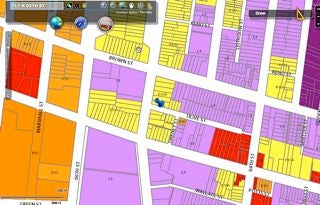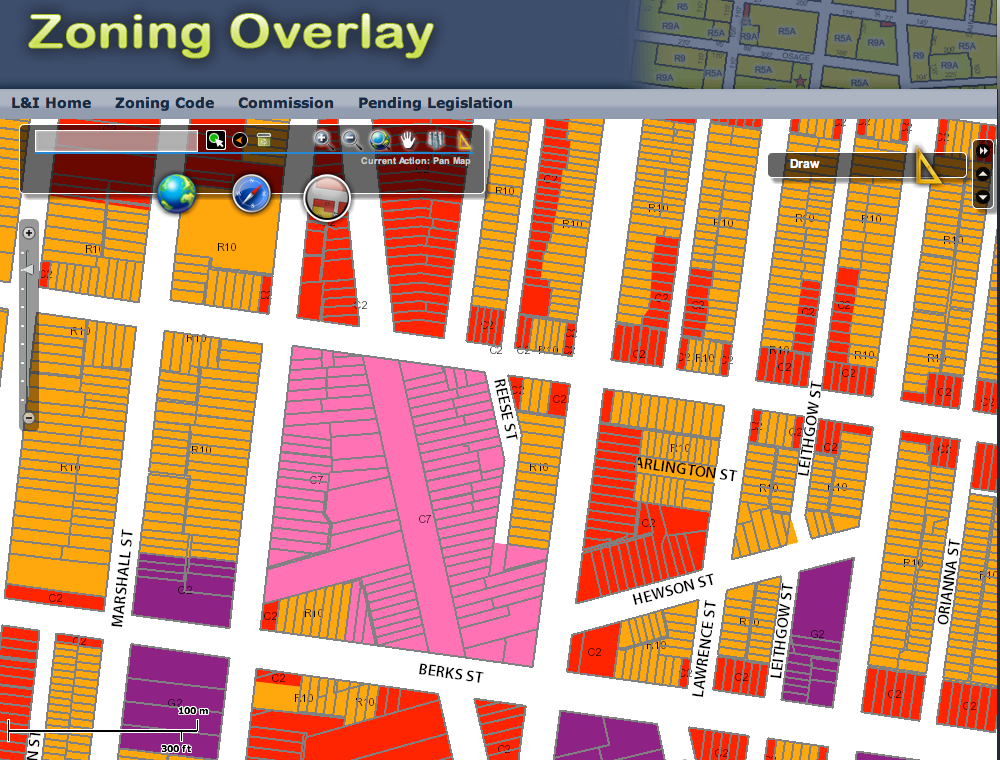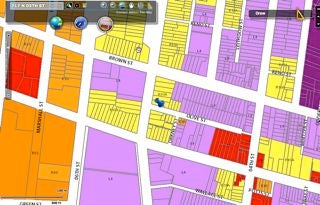Cutting through the Zoning Code: “Use Regulations”
So I can’t deliver on my promises to tell you who gets what quite yet. That’s going to be determined when the city gets remapped. But digging through the use guidelines in the revised code reveals a new commitment to permitting increased sustainable land use and improving access to fresh food; to banning strip clubs, drug paraphernalia sales, and gun shops from all residential and commercial districts; and to putting together useful tables that let Philadelphians figure out what’s what.
Chapter 14-500: Use Regulations details ten main land-use categories: residential; parks and open space; public, civic, and institutional (such as government buildings, schools and libraries); office; retail; commercial services; vehicle and vehicular equipment sales and services (i.e. car lots and mechanics); wholesale, distribution, and storage; industrial; and urban agricultural. This chapter brings together the use regulations that are scattered about the current code, and organizes them into those handy tables I mentioned. I still do a lot of cross-referencing, but at least the basic information is all in one place.
Also handy: the tables, at least for this draft, also include the old zoning districts alongside the new, so readers can see what their current districts are likely to become. If you’re unsure how your home or business (or nearby lots of concern) is zoned, check out the city’s zoning overlay map. My apartment lies in R-10A!

I’m intrigued by the map, because as I look at the blocks around my apartment, I see a lot of rowhouses, as well as a building of loft apartments, on blocks that are zoned L-4. L-4 is an industrial district that specifically prohibits, um, dwellings. And whoops, look at that! R-10A prohibits multi-family buildings, and the building I live in has five apartments, although I believe it was cut up before the block became R-10A. This district has problems not only with nonconforming uses, but also with nonconforming lots. According to a March 2009 report from Clarion Associates and Duncan Associates, 90 percent of R-10A lots are nonconforming. As I read deeper into the code, I understand more and more why so many cases go before the Zoning Board of Adjustment.
These tables detail what uses will be of-right; that is, what residents, businesses, and developers are legally permitted to do regardless of what their neighbors may think. Applications still go to the Department of Licenses and Inspections (L&I), which classifies the use proposed for a site. If the intended use of the site is unclear, or if L&I can not figure out a use category based on the application, it can deny a permit.
An extreme example: I think that if I wanted to build a spaceport to launch rockets that carry satellites to orbit, L&I would deny my request. But I could appeal to ZBA. Would I win? Probably not. But the right of appeal remains, because unless I’m reading it incorrectly, the revised code does not address spaceports.
Numerous items are included in the code to address the problem of food deserts in Philadelphia—areas where fresh produce is hard to come by. Farmer’s markets are now permitted in residential mixed-use districts, and floor area incentives now exist to encourage the construction and expansion of “fresh food markets” in those same districts. The code offers two definitions for these markets. The first appears to accommodate small shops, where the sale of fresh fruits and vegetables occupies at least 65% of the gross floor area. The second is for grocery stores where over 5,000 square feet are dedicated to groceries, where 25% of the sales floor is dedicated to perishable goods, and where at least 750 square feet are dedicated to fresh fruits and vegetables.
Want additional floor area? A fresh food market can be 50% larger than the maximum retail use normally allowed, and if you build (or expand) one, you get a one-for-one floor area bonus. If you build a 10,000-square-foot market, you get 10,000 extra square feet for your building. To top it off—bad pun intended—a building containing a market can exceed maximum building heights in order to squeeze in its floor area bonus. And any market less than 10,000 square feet in size is exempt from off-street parking requirements.
Let’s look at some maybe-vices, or more aptly, those uses likely to be flashpoints in certain neighborhoods:
- Arcades, tattoo parlors, and pool halls are all removed from the list of regulated uses (those uses which normally trigger a neighborhood meeting).
- Arcades and pool halls are permitted only by exception in every commercial district except CMX-1, and by exception in every industrial district except I-TU and I-3. In the latter, arcades and pool halls are permitted of right.
- Tattoo parlors are permitted by right in every industrial district except I-TU, and by special exception in every commercial district except CMX-1.
- Adult-oriented services (read: strip clubs, massage parlors) and merchandise (read: sex toy shops) are not allowed in commercial or residential districts. Ditto for gun shops, and stores that sell drug paraphernalia. Note: this is a change from the draft revision of the code, which permitted them in certain commerical districts. You can download the most recent edits here.
- No restaurants or bars in residential areas, except in residential mixed-use areas, where they will be permitted of-right.
- Liquor and beer sales are permitted of-right in all commercial districts, except CMX-2.5, the district that replaces the Neighborhood Commercial Corridor overlay. State liquor stores can operate in CMX-2.5 (the city can’t really restrict state activity—see: casinos). The beer restriction would prohibit a high-end shop like Food & Friends at 20th and Spruce from operating in that district—some commercial districts might want a shop like that. At the same time, it would prohibit a shop that sold nothing but Zima (it’s still around!). What do I know—some districts might want that too!
- The sale of tobacco products is also newly regulated: no sales within 500 feet of schools. The code doesn’t say anything about businesses being grandfathered in, so I’m wondering how this is going to affect corner stores and freestanding newsstands in denser parts of the city.
A number of other notable items:
- Cultural institutions like libraries and museums are now officially permitted in all commercial districts.
- Excluding the single-family detached districts, bed-and-breakfasts are now permitted in all residential districts.
- Places of religious assembly are now allowed in single-family residential districts, and continue to be allowed along commercial corridors.
- The urban agriculture category grows wide enough to include sites like Greensgrow in Kensington, and the roof of West Philadelphia’s Mariposa Co-op, according to the plans for their new building on Baltimore Avenue.
- Artisan manufacturing has been added to all commercial districts except CMX-1. Read: you make jewelry in the shop you run, and now that’s legit. Except in CMX-1.
- The IRMX district—the one designed to repurpose some of Philadelphia’s abandoned industrial buildings as locations for both residences and workplaces, does so. Hey jewelry-maker, you can live in your loft studio!
- Clear parameters are laid out in new section on roof decks—perhaps a ZBA trip won’t be necessary every time a homeowner wants to build one?
- And speaking of roofs (and alternative energy), wind turbines and solar panels are now permitted in all zoning districts. The code has regulations for how you can get green, should you wish to get there.
- To get satellite dishes off the facades of buildings, a bill is making its way through council that regulates their placement; those regulations are included here.
- And the proposed accessory dwelling units, which PlanPhilly has covered previously here and here.
When we return: the nitty-gritty of how we (will) do in Philadelphia—development standards! This includes form and design regulations, the new transit-oriented development areas, civic design review, and more fun topics on which everybody will indeed have an opinion.
In the meantime, don’t forget:
- Visit the ZCC’s Virtual Open House to give feedback on the zoning matters of concern to you.
- The last in-person ZCC open house is at the Independence Visitors Center, Sixth and Market Streets, Tuesday, November 9 at 10:00 a.m.
- The deadline for written comments on the draft revision of the zoning code is Friday, November 12.
- And if you want to talk about how the zoning revision might affect you or your business, email me at ngilewicz@planphilly.com.
Until next time!
Contact the reporter at ngilewicz@planphilly.com
WHYY is your source for fact-based, in-depth journalism and information. As a nonprofit organization, we rely on financial support from readers like you. Please give today.






